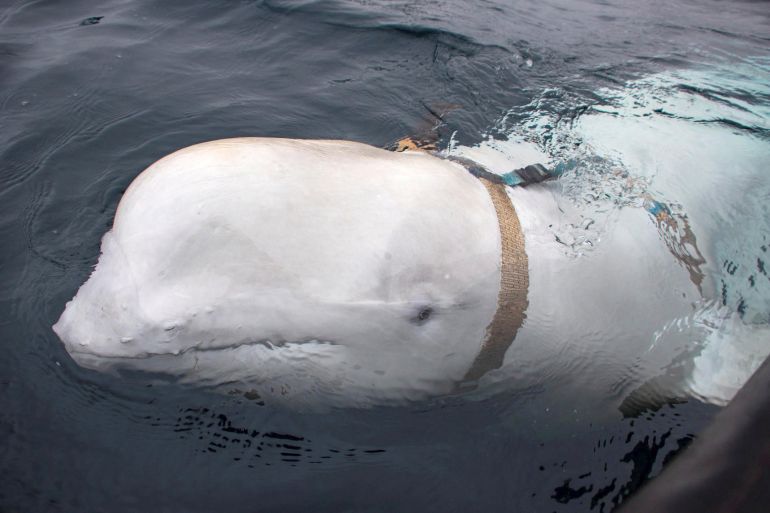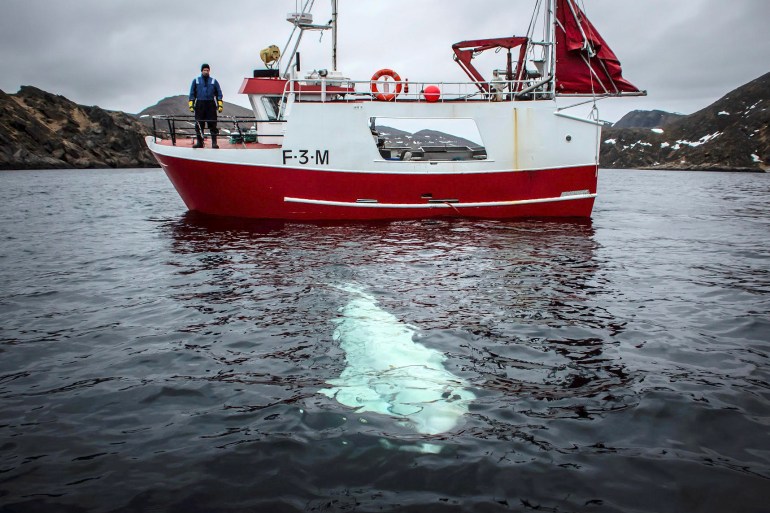Russian ‘spy’ whale Hvaldimir spotted off Sweden coast
Norwegian officials believe the beluga whale may have been trained by Russia’s navy and is accustomed to humans.

A beluga whale that turned up in Norway in 2019, sparking speculation it had been trained by the Russian navy because of a man-made harness it was wearing, has reappeared off Sweden’s coast, an organisation tracking his movements has said.
When he first appeared in Norway’s northern Arctic region of Finnmark, marine biologists from the Norwegian Directorate of Fisheries removed an attached harness with a mount suited for an action camera and the words “Equipment St Petersburg” printed on the plastic clasps.
Keep reading
list of 4 itemsRussia-Ukraine latest updates: Shelling of Azovstal resumes
Medvedev sacks Russia spy chief
US ex-Marine will not appeal Russia spy verdict in hopes of swap
Directorate officials said at the time that the whale may have escaped an enclosure, and may have been trained by the Russian navy, as it appeared to be accustomed to humans.
Norwegians nicknamed the beluga “Hvaldimir” – a pun on the word “whale” in Norwegian, hval, and “dimir”, a nod to its alleged association with Russia.
The OneWhale organisation said on Monday that Hvaldimir had spent more than three years slowly moving down the top half of the Norwegian coastline before suddenly speeding up in recent months to cover the second half and moving on to Sweden.
On Sunday, he was observed in Hunnebostrand, off Sweden’s southwestern coast, the organisation said.
BREAKING NEWS: Hvaldimir has left Norwegian waters and is now in Sweden. We are working with the Swedish authorities. pic.twitter.com/9JQpVdcB6T
— OneWhale (@onewhaleorg) May 29, 2023
“We don’t know why he has sped up so fast right now,” especially since he is moving “very quickly away from his natural environment”, Sebastian Strand, a marine biologist with the OneWhale organisation, told the French news agency AFP.
“It could be hormones driving him to find a mate. Or it could be loneliness, as belugas are a very social species – it could be that he’s searching for other beluga whales.” Believed to be between 13 and 14 years old, Hvaldimir is “at an age where his hormones are very high”, Strand said.
But the closest population of belugas is located in the Svalbard archipelago, in Norway’s far north. The whale is not believed to have seen a single beluga since arriving in Norway in April 2019.
On its website, the OneWhale organisation says, “Hvaldimir is not a wild whale. He behaves like a lost or abandoned domesticated animal. Instead of avoiding people, he seeks them out.”

Moscow never issued any official reaction to Norwegian speculation that the whale could be a “Russian spy”.
The Barents Sea is a strategic geopolitical area where Western and Russian submarine movements are monitored. It is also the gateway to the Northern Route that shortens maritime journeys between the Atlantic and Pacific oceans.
Strand said the whale’s health “seemed to be very good” in recent years, foraging wild fish under Norway’s salmon farms. But his organisation was concerned about Hvaldimir’s ability to find food in Sweden, and they already observed some weight loss.
Beluga whales, which can reach a size of six metres (20 feet) and live between 40 and 60 years, generally inhabit the icy waters around Greenland, northern Norway and Russia.